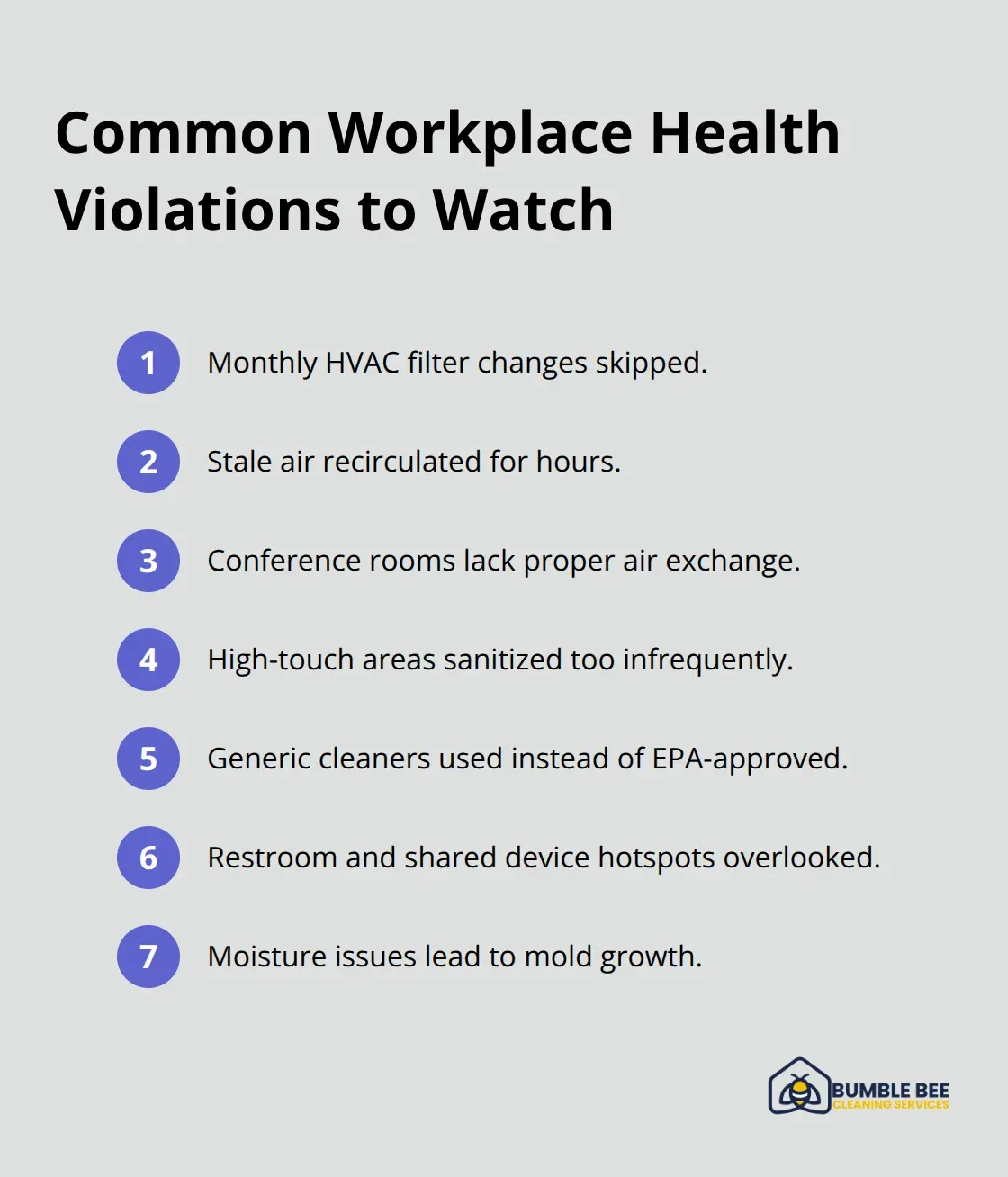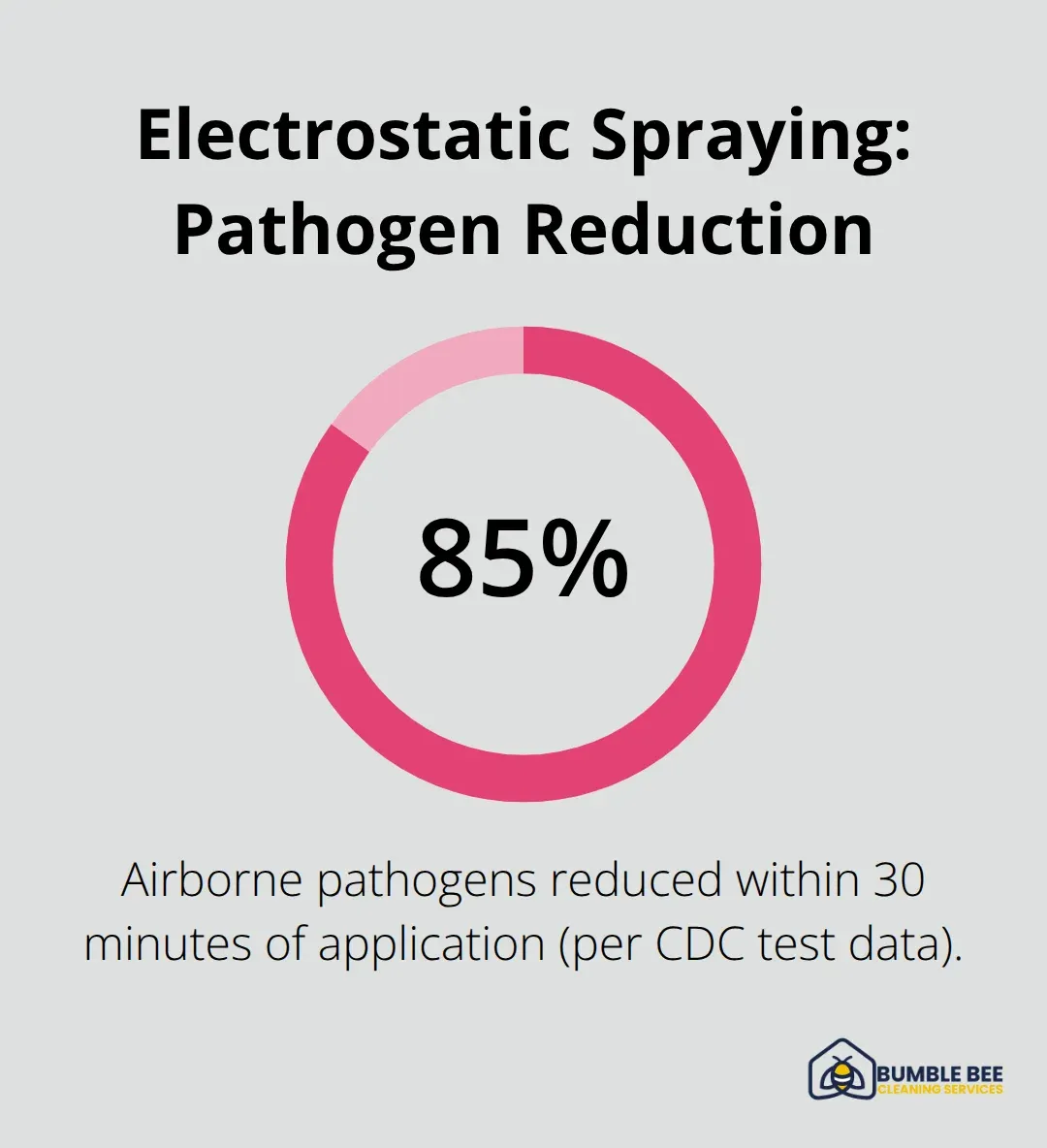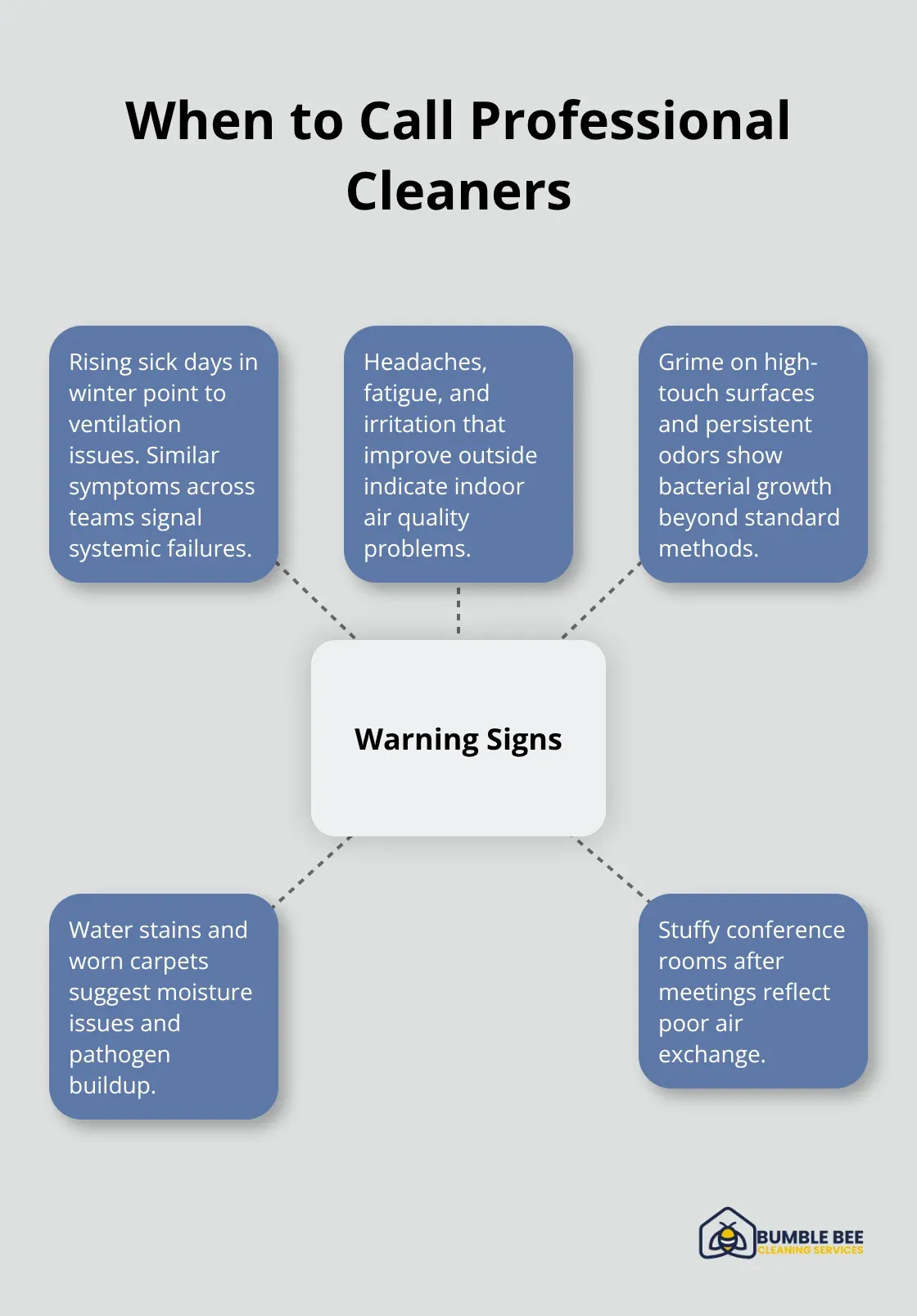Seattle workplaces face mounting pressure to meet strict health standards, yet many fall short without realizing it. Poor air quality, inadequate cleaning protocols, and overlooked maintenance issues create environments that harm employee wellness.
We at Bumble Bee Cleaning Services see these violations daily across the city. Commercial sanitization has become more important than ever for protecting your team’s health and productivity.
Common Health Standard Violations in Seattle Workplaces
Ventilation Systems Create Silent Health Threats
Seattle workplaces harbor ventilation problems that remain invisible until employees develop health issues. Poor air circulation creates ongoing workplace health concerns as employers must provide safe workplaces under Washington state requirements. Most office buildings recirculate stale air for hours, which traps allergens, bacteria, and chemical fumes inside work spaces.
HVAC filters receive changes every six months instead of the recommended monthly replacement schedule. This practice allows dust and contaminants to accumulate throughout the system. Conference rooms without proper air exchange become hotspots for airborne illnesses, particularly during Seattle’s wet months when windows remain sealed shut.

Cleaning Protocols Fall Short of Health Requirements
Most Seattle businesses clean surfaces once daily, yet health standards require high-touch areas like door handles and elevator buttons to receive sanitization every four hours. The 2023 workplace data shows that respiratory illnesses occurred at a rate of 9.5 cases per 10,000 workers, highlighting the importance of proper cleaning protocols.
Restrooms receive basic cleaning while staff overlook areas like water fountain spigots, phone receivers, and keyboard surfaces where germs multiply rapidly. Many companies use generic cleaners instead of EPA-approved disinfectants, which leaves harmful bacteria alive on surfaces for days.
Maintenance Issues Compromise Employee Safety
Broken ceiling tiles, water stains, and flickering lights reveal deeper problems that threaten workplace health. Seattle’s high humidity creates mold growth in poorly maintained buildings, which triggers respiratory issues among staff members. Carpet stains and worn flooring harbor bacteria and allergens that standard vacuuming cannot eliminate.
Leaky pipes and poor drainage systems create moisture problems that lead to structural damage. These issues affect air quality and reduce employee productivity (while increasing health risks). Professional cleaning services address these violations through specialized protocols and equipment designed to meet Seattle’s strict health standards.
How Professional Services Meet Seattle Health Standards
Professional cleaning companies transform workplace health through systematic approaches that target specific contamination sources. EPA-approved disinfectants eliminate 99.9% of harmful bacteria when teams apply them correctly, while generic cleaners leave dangerous pathogens active for up to 72 hours on surfaces. Professional services implement hospital-grade protocols that sanitize high-touch areas every two hours instead of the standard daily schedule most businesses follow.
Advanced Disinfection Eliminates Health Threats
Electrostatic spray technology distributes disinfectant particles evenly across all surface types and reaches areas traditional methods miss completely. This process reduces airborne pathogens by 85% within 30 minutes of application according to CDC test data. Professional teams use color-coded microfiber systems that prevent cross-contamination between restrooms, kitchens, and office spaces. Steam treatment at 212°F temperatures kills viruses and bacteria that survive standard sanitization methods.

Specialized Equipment Improves Air Quality
HEPA filtration systems remove a minimum of 99.97% of particles as small as 0.3 microns and capture allergens plus contaminants that trigger respiratory issues among employees. Professional-grade air scrubbers process 2,000 cubic feet of air per minute while they cycle complete room air every 15 minutes during deep sessions. UV-C light sanitization destroys DNA structures in harmful microorganisms without chemicals that leave residues (which can irritate sensitive employees).
Regular Maintenance Prevents Health Violations
Professional services establish maintenance schedules that address problems before they become health hazards. Teams inspect HVAC systems monthly and replace filters on schedule to maintain proper air circulation. They identify moisture issues early and treat affected areas with antimicrobial solutions that prevent mold growth.
These comprehensive approaches create healthier work environments, but you need to recognize when your workplace requires professional intervention to protect employee wellness.
Signs Your Workplace Needs Professional Cleaning Intervention
Your workplace sends warning signals when health standards deteriorate, and you must recognize these signs to prevent costly health violations before they escalate. Employee absences provide the most reliable indicator of workplace health problems, as research shows sick leave patterns correlate with workplace conditions. Weekly absence patterns reveal health trends that surface cleaning cannot address.
Employee Sick Days Signal Health Problems
Staff respiratory complaints multiply when HVAC systems circulate contaminated air for extended periods. Seattle workplaces with inadequate ventilation report higher sick day usage during winter months when buildings remain sealed. Teams develop illnesses that spread rapidly through shared spaces, which indicates surface contamination exceeds your current capacity. Multiple employees experience similar symptoms within short timeframes, and this signals systemic failures that require immediate professional intervention.
Visible Contamination Indicates Deeper Issues
Grime accumulates on high-touch surfaces like elevator buttons, door handles, and conference room tables (this indicates bacterial growth that standard methods miss completely). Carpet stains and worn areas harbor pathogens, while water stains on ceiling tiles reveal moisture problems that create mold growth. Kitchen areas develop persistent odors and visible buildup around appliances, sinks, and coffee stations where employees gather frequently.
Air Quality Problems Affect Daily Operations
Stale air and poor circulation create environments where allergens and contaminants concentrate throughout work hours. Employees complain about headaches, fatigue, and respiratory irritation that improves when they leave the building. Conference rooms feel stuffy after meetings, and common areas develop unpleasant odors that linger despite regular maintenance efforts (particularly during Seattle’s humid months when windows stay closed).

Professional intervention becomes necessary when these warning signs appear consistently across your workplace environment.
Final Thoughts
Seattle workplaces cannot afford to ignore health standards when employee wellness directly impacts productivity and business success. The 2023 data shows Washington’s workplace injury rate of 3.4 cases per 100 workers exceeds the national average. This makes professional intervention necessary rather than optional for most businesses.
Commercial sanitization through professional services creates measurable improvements in workplace health. Teams experience fewer sick days, reduced respiratory complaints, and improved air quality when businesses implement comprehensive protocols. Professional services eliminate 99.9% of harmful bacteria while they address ventilation issues that standard methods miss completely.
Action starts with recognition of warning signs and partnership with experienced professionals who understand Seattle’s specific health requirements (and the regulations that govern them). We at Bumble Bee Cleaning Services provide comprehensive commercial solutions that help workplaces meet health standards. Our team delivers the expertise your workplace needs to protect employee wellness through proven protocols and specialized equipment.
